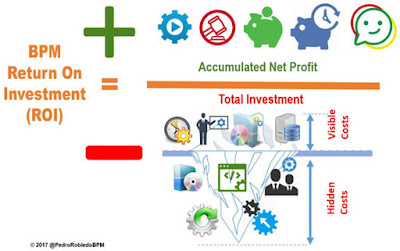As the implementation of BPM (Business Process Management) in your organization is not only the implementation of BPM technology, to analyze the profitability to be obtained it is necessary to take into account the entire BPM Life Cycle. You must evaluate both the investment to be made and the benefits in each phase. It is also necessary to take into account in the analysis the number of BPM projects that will be implemented during the time period of study so that all costs in the project to be studied will not be reimbursed, but will be divided proportionally.
A priori it is possible to know the amount of the investment of a BPM initiative in the organization, but what is more difficult is to estimate the benefits that we can obtain of that investment. That is, as reflected in the investment made in the organization, understanding that they will generate positive changes in it, qualitative and quantitative. In many cases, the very need to solve a problem in the organization already guarantees the investment, but even so it will be convenient to analyze the return.
In order to start the analysis correctly, it will be useful to have current metrics of the previous situation of the organization before starting the BPM initiative, so that they provide us the benefit to achieve according to the objectives.
The profitability is analyzed by the calculation of ROI (Return On Investment), which is a method that allows us to evaluate the value that gives us the realization of a certain project or investment in Business Process Management. This analysis compares the return on investment over costs by building a ratio or percentage to give us an idea of how much is recovered for each euro that is invested. If we consider the rate of return to be 6 months, a figure of 100% means that the investment returns in 6 months, 200% in three months and so on. An investment rate of less than 0% means that resources have been lost in the project.
Two ROI calculations are recommended for a complete analysis, the expected ROI (calculation of the initial ROI when the BPM initiative is in the project phase) and the Actual ROI (ROI calculation during the implementation and deployment of BPM in the organization). This last ROI will be useful for future projects, to know if the current projects are productive for the organization and what have been the advantages and problems of the deployment and deployment.
Based on my experience as a consultant supporting and advising companies in the calculation of ROI, the organizations ask mainly four questions of profitability: how much will they pay for the costs in the implantation and the deployment ?, how to transform the non-economic benefits in economic values for the analysis ?, how to control the risks that can be generated during the implantation so that the analysis is useful? And how to perform the analysis?





